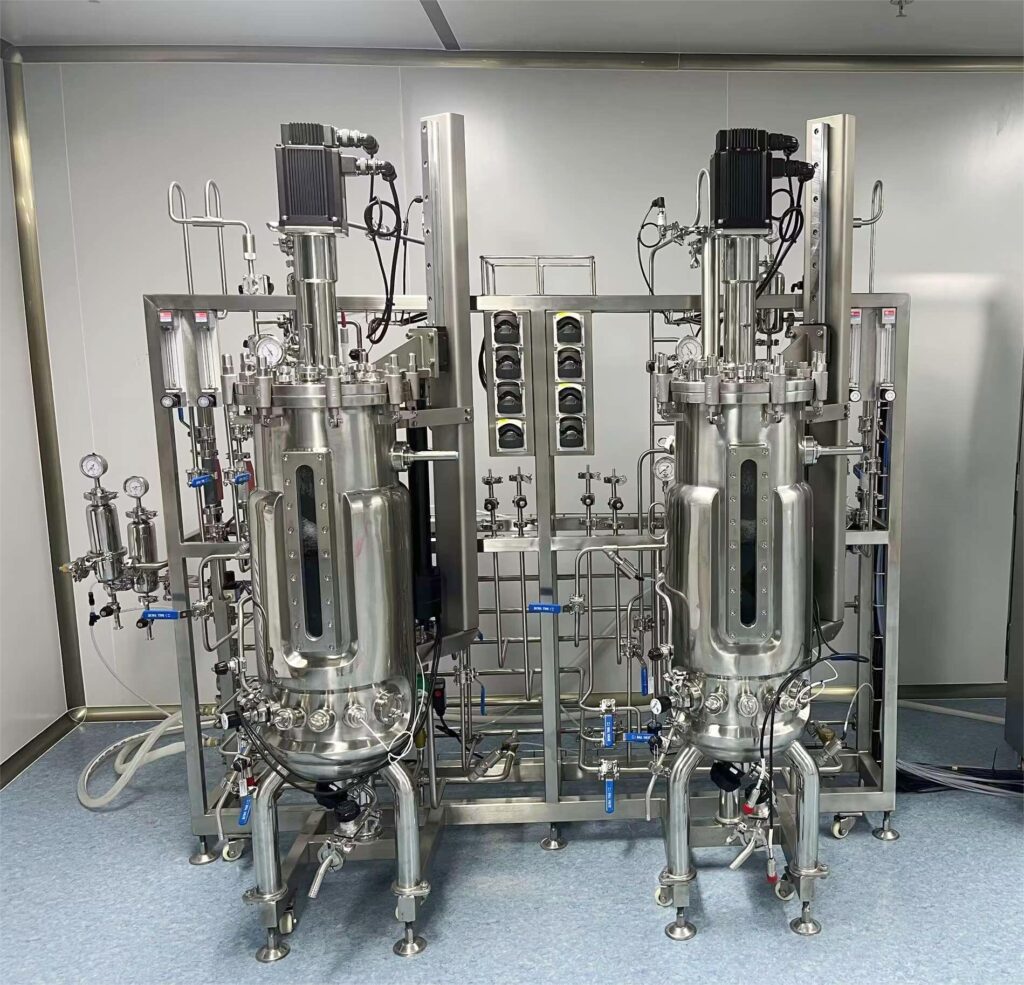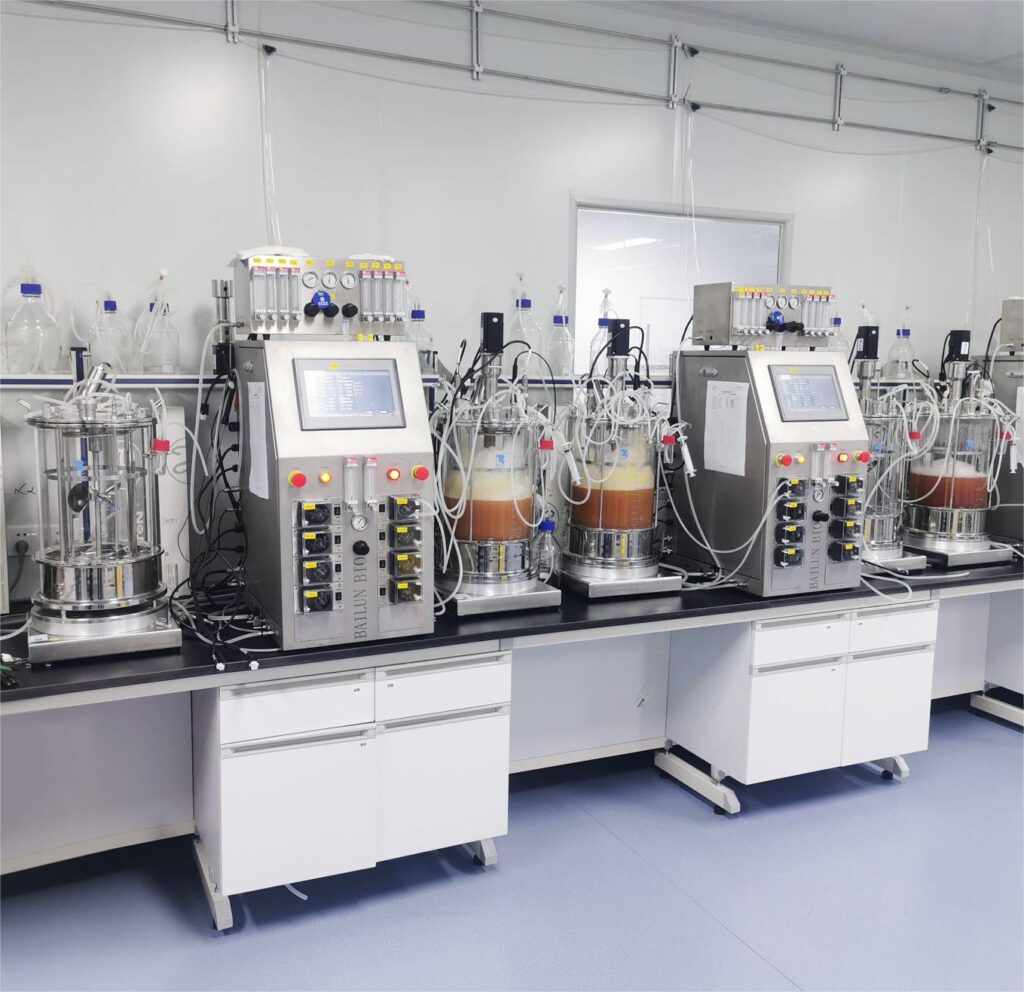Microbial fermentation refers to the process of using microorganisms to convert raw materials into products required by humans through specific metabolic pathways under suitable conditions. The level of microbial fermentation production mainly depends on the genetic characteristics and cultivation conditions of the strains themselves. The application scope of fermentation engineering includes pharmaceutical industry, food industry, energy industry, chemical industry, agriculture: transforming plant genes; Biological nitrogen fixation; Engineering insecticidal and biopesticides; Microbial nutrients. Environmental protection and other aspects.
Microbial fermentation methods generally include batch fermentation, continuous fermentation, and feed batch fermentation.

Bailun stainless steel fermenter
(1) Continuous fermentation
It refers to adding fresh culture medium to the fermenter at a certain speed, while flowing out the culture medium at the same speed, so as to maintain a constant amount of liquid in the fermenter and allow microorganisms to grow in a stable state. Can be carried out continuously for a long time, with high production capacity; But the operational control requirements are high, with high investment, contamination of miscellaneous bacteria, and variation of microbial strains. Fermenter are mainly used for laboratory fermentation kinetics research, and their application in industrial fermentation is not common. They are only used for fermentation with relatively stable selection properties of strains, such as alcohol fermentation, etc
(2)Batch fermentation
Batch fermentation, also known as batch culture, is a fermentation method that involves adding bacterial cells to a certain amount of culture medium for cultivation, and finally harvesting the bacterial cells or their metabolites in one go. In batch fermentation, in order to maintain the concentration of nutrients in the culture medium in an environment suitable for bacterial growth and conducive to the accumulation of metabolic products by bacterial volume, intermediate feeding can be used. The common batch fermentation method in the fermentation industry is to use a single tank deep batch fermentation method. Batch fermentation requires relatively simple technology and equipment, making it easy for people to master. Therefore, it is still the mainstream of the fermentation industry today, and traditional fermentation industries generally use batch fermentation method. Each batch fermentation process undergoes inoculation, growth and reproduction, bacterial aging, and ultimately the fermentation ends, resulting in the extraction of the product.
Under the control of certain culture media conditions, microorganisms undergo a series of stages of change from birth to death, each of which is constrained by the characteristics of the bacterial body and also influenced by the surrounding environment. Only by correctly understanding and mastering this series of changes can we control fermentation production. The characteristics of batch fermentation are that the environment in which microorganisms are located is constantly changing, and a small number of varieties of fermentation production can be carried out. If there is contamination by miscellaneous bacteria, the operation can be easily terminated. When the operating conditions change or new products need to be produced, the fermentation strategy is easy to change, and the requirements for raw material composition are relatively extensive. The microbial growth process in batch culture can be divided into four stages: stagnation (or adjustment) phase, logarithmic (growth) phase, stable phase, and decay phase. It is advisable to use logarithmic phase cells with the most vigorous growth to study the metabolism and genetics of cells. In the production of fermentation industry, the seeds used should be in the logarithmic phase. When they are inoculated into the fresh culture medium of the fermentation tank, there is almost no stagnation period, which can obtain a large number of vigorously growing bacterial cells in a short period of time, which is conducive to shortening the production cycle. In research and production, it is often necessary to extend the logarithmic growth stage of cells.
The main equipment for batch fermentation is the main fermenter (main fermenter) and the seed fermenter (seed fermenter), both of which belong to deep cultivation devices. (Contains ingredients, steam sterilization, cooling, ventilation, air filtration, stirring, and defoaming devices, etc.). Seed tank: The seed of the required strain for inoculating the main fermenter culture medium. Shake bottle culture – seed culture – fermentation culture (gradually expanding by 10 times the volume).Batch fermentation is a good fermentation method widely used in industrial production.
Factors affecting the total yield during batch fermentation process: ① Substrate factors: Inappropriate substrate selection leads to substrate limitation or inhibition, resulting in substrate decomposition inhibition effect and secondary growth phenomenon. ② The impact of bacterial strains and metabolic product types: Fermentation bacterial strains have weak adaptability and cannot quickly adapt to substrate types and fermentation environments, or the products are secondary metabolites that are sensitive to initial high concentrations, affecting the total yield of batch fermentation Limitations of fermentation type itself: Batch fermentation is a typical non steady state process, with one-time feeding and inoculation until the fermentation is completed without opening the lid. Nutrients will be exhausted quickly, making it impossible to maintain the continued growth and production of microorganisms; ④ The impact of microbial growth stage: Long non production time leads to lower productivity.

Bailun glass fermenter bioreactor
(3)Fed batch fermentation
Batch fermentation, also known as semi continuous fermentation or semi continuous cultivation, refers to the cultivation method of intermittently or continuously adding fresh culture medium during the batch fermentation process. Compared with traditional batch fermentation, its advantage lies in maintaining a very low substrate concentration in the fermentation system. The advantages of low substrate concentration are: ① it can remove the inhibitory effect of rapid utilization of carbon sources and maintain an appropriate bacterial concentration, so as not to exacerbate the contradiction of oxygen supply; ② Avoid the accumulation of toxic metabolites in the culture medium.
Feed batch fermentation is widely used in the production of antibiotics, amino acids, enzyme preparations, nucleotides, organic acids, and polymers.For example, most Escherichia coli fermentation uses batch feeding culture, which is a way to optimize modern fermentation processes and effectively optimize the chemical environment during microbial cultivation. Place microorganisms in the optimal growth environment.Compared with batch fermentation, feed batch fermentation can relieve substrate inhibition, product feedback inhibition, and glucose decomposition inhibition effects. Avoid excessive cell growth and oxygen consumption caused by excessive one-time sugar addition in batch fermentation, which may result in mismatched ventilation and stirring equipment. The bacterial body can be controlled in a series of continuous transitional stages, which can be used as a means to control cell quality. Compared with continuous fermentation, the advantages of fed batch fermentation are: ① low sterile requirements; ② Strain variation with minimal degradation; ③ Wider applicability.
Contact Us:
Add:6848# Liuxiang Rd., Jiading, Shanghai, China
Contact Person: Maddie
Email:[email protected]
Phone:+86-134-7276-8163 (WhatsApp)
Website: https://fermentorchina.com/
